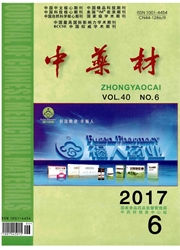

 中文摘要:
中文摘要:
目的:观察苓桂术甘汤对心室重构大鼠心肌组织NF-κB信号通路相关分子表达的影响,探讨其抑制心室重构的分子机制。方法:采用冠脉结扎复制心梗后心室重构大鼠模型,造模2 w后,药物连续干预4 w,采用Western blot法检测模型大鼠心肌组织NF-κBp65、IKK-β、IκB-α及p-IκBα的蛋白表达,采用ELISA法检测大鼠血清中TNF-α、IL-1β及IL-6的含量,采用HE及Masson染色观察大鼠心肌组织病理学变化。结果:心室重构模型大鼠出现明显的心肌细胞损伤及间质纤维化等病理变化,与假手术组比较,心肌组织NF-κBp65、p-IκBα蛋白表达显著升高,IKK-β、IκB-α蛋白表达显著降低,血清TNF-α、IL-1β、IL-6含量显著升高(P〈0.01)。与模型组比较,苓桂术甘汤各剂量干预4 w后,可显著改善模型大鼠心肌组织损伤,抑制NF-κBp65、p-IκBα蛋白表达、上调IKK-β、IκB-α蛋白表达,降低血清TNF-α、IL-1β及IL-6含量(P〈0.05或P〈0.01)。结论:苓桂术甘汤改善心肌组织损伤、抵制心室重构的作用机制与抑制心肌组织NF-κB信号通路过度激活有关。
 英文摘要:
英文摘要:
Objective : To investigate the effect of Linggni Zhugan decoction on the expression of related molecules of NF-KB signa- ling pathway in myocardium of rats with ventricular remodeling, and to explore the molecular mechanism of inhibiting ventricular remod- eling. Methods:A ventricular remodeling model was generated by ligation of coronary artery in rats ,2 w after surgery, rats were treated by drugs for 4 w. Western blot was used to examine the expression of NF-KBp65, IKK-β, IKB-a and p-IKBa, ELISA assay was used to detect the content of TNF-a,IL-Iβ and IL-6. HE staining and Masson staining were used to observe the morphological changes of myo- cardium in rats. Results:The model rats with ventricular remodeling showed significant changes in myocardial cell injury and interstitial fibrosis. Compared with sham operation, the expression of NF-KBp65 and p-IKBa in myocardial tissue of model rats increased signifi- cantly, while the expression of IKK-β and IKB-a decreased significantly, and the content of TNF-a, IL-β and IL-6 increased significant- ly(P 〈0.01 ). Compared with the model group, Linggui Zhugan decoction groups could significantly improve myocardial tissue injury and inhibit the expression of NF-KBp65 and p-IKBa, and up-regulate the expression of 1KK-β and IKB-a, decrease the content of TNF- a, IL-1β and IL-6 in serum (P 〈 0. 05 or P 〈 0. 01 ). Conclusion : Linggui Zhugan decoction can improve myocardial tissue injury and in- hibit ventricular remodeling by inhibiting the excessive activation of NF-KB signaling pathway.
 同期刊论文项目
同期刊论文项目
 同项目期刊论文
同项目期刊论文
 期刊信息
期刊信息
